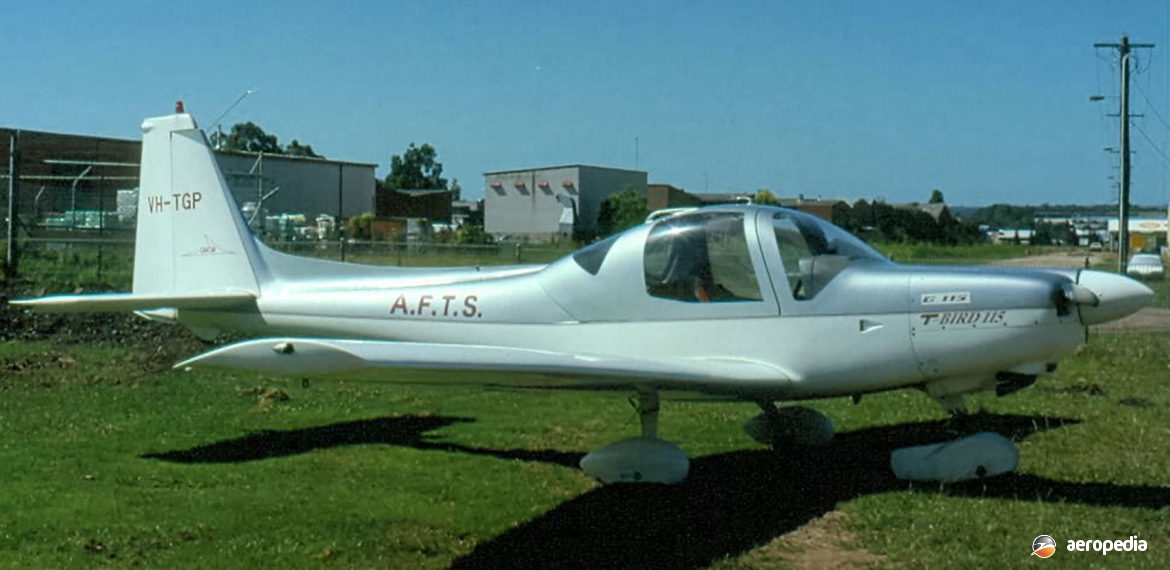Photograph:
Grob G-115A T-Bird VH-TGP (c/n 8086) at Bankstown, NSW in 1997 (David C Eyre)
Country of origin:
Germany
Description:
Two-seat training and touring aircraft
Power Plant:
One 119 kw (160 hp) Textron Lycoming O-320-D1A four-cylinder horizontally-opposed air-cooled engine
Specifications:
- Wingspan: 10 m (32 ft 9½ in)
- Length: 7.44 m (24 ft 5 in)
- Height: 2.75 m (9 ft 0¼ in)
- Wing area: 12.21 m² (131.4 sq ft)
- Max speed at sea level: 317 km/h (196 mph)
- Cruising speed at 75% power: 240 km/h (149 mph)
- Max rate of climb at sea level: 387 m/min (1,270 ft/min)
- Stalling speed flaps down: 85 km/h (53 mph)
- Service ceiling: 4,875 m (16,000 ft)
- Range with max fuel, no reserve: 1,204 km (748 miles)
- Empty weight: 650 kg (1,433 lb)
- Loaded weight: 920 kg (2,028 lb)
History:
The Grob G-115 was one of the first aircraft to achieve full certification and go into full production, being constructed of glass-fibre reinforced plastics (GFRP). The G-115 was the third aircraft of this type designed and built by Grob, the first being the G-110 (D-EBGF), of which two prototypes were built, first flown in February 1982 with an 88 kw (118 hp) Lycoming O-235 engine. Two years later the G-112 appeared, three prototypes being built with a shorter wing span and a 67 kw (90 hp) GVW.2500 engine. This led to the G-115, the prototype of which first flew on 15 November 1985. German certification was received in March 1987, and United States approval was received in December of the following year.
Burkhart Grob Flugzeugbau of Mindelheim, Germany, was founded as a division of Grob-Werke GmbH and Company in 1972 and since then has designed and produced a successful series of light aircraft, the first of these seen in Australasia being the G-109 series. Ssubsequently the G-115 series appeared, being a two-seat training monoplane with a variety of engines. The range originally included the G-115A with the 86 kw (115 hp) Textron Lycoming O-235 engine fitted with a fixed-pitch propeller; the G-115B with the 119 kw (160 hp) Textron Lycoming O-320D engine with a constant-speed propeller; the G-115C, similar to the G-115B with a constant-speed propeller; and the Sports Acro with a 134 kw (180 hp) Lycoming AEIO-360-B engine with an inverted fuel and oil system, and a constant-speed propeller, which was fully aerobatic. Dual controls were fitted in all aircraft, and fuel capacity was 100 litres (22 Imp gals).
The prototype of the new series flew for the first time in November 1985, the second prototype flying in the following year, both having Textron Lycoming O-235 engines. The third prototype for the G-115B series also flew for the first time in 1986.
On 29 April 1988 a new variant known as the G-116 was flown, this essentially being a four-seat variant of the G-115 with a 134 kw (180 hp) Lycoming IO-360 engine, this providing a cruising speed of 255 km/h (158 mph) at 75 per cent power.
In 1992 power plant, equipment and designations were changed. The G-115A became the G-115B with a 119 kw (160 hp) Textron Lycoming O-320 engine; the G-115C in the 1993 model had a 119 kw (160 hp) Textron Lycoming O-320 engine, fuel tanks in the wings and a number of other improvements; and the G-115D was a fully aerobatic model of the G-115C with a 134 kw (180 hp) Textron Lycoming AEIO-360.
In due course the G-115T with a 194 kw (260 hp) engine and a retractable undercarriage was built, the prototype of which flew for the first time on 11 June 1992.
In 1989 the Australian Aviation College, with bases at Parafield, SA, and Bankstown, NSW, took delivery of, and placed into service, ten examples of the G-115 for training work. Subsequently more than 45 examples appeared on the Australian register and variants include G-115C-2 VH-AWX (c/n 82023/C2); G-115B-T-Bird VH-AYB (c/n 8102); and G-115D Acro VH-AYX (c/n 82007/D). The Australian Flying Training School at Bankstown, NSW added the type to its fleet in 1994 and had it certified for spinning so it could be included in the training program; later adding night VFR training. The China South West Australia Flying College at Jandakot, WA operated a fleet of 32 Grobs from 1996.
The type was also chosen as a trainer for the Royal Air Force (RAF) and the Royal Navy (RN) where it was known as the Tutor, being used by University Air Squadrons (UAS) in RAF markings with civil registrations. The first unit to receive the type was Cambridge, 99 being ordered to replace Scottish Aviation Bulldogs with UAS and Air Experience Flights operated under civilian contracts by Bombardier Services.
In 2001 the G-115TA advanced military trainer was placed in production, this model having a retractable undercarriage, 12 being delivered to the United Arab Emirates Air Force.
By mid 2013 many of the G-115s in Australia were being retired and scrapped, having met their airframe lives, two being donated to the Australian Aviation Museum at Bankstown and were on display until the museum closed.

